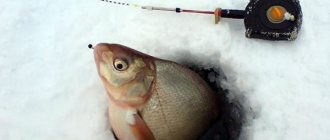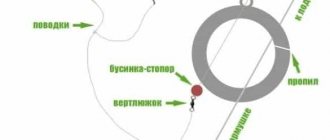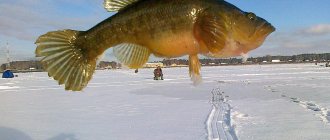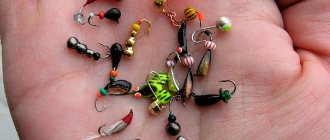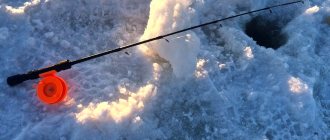This ancient and effective method of fishing used to be called “Florentayka” or “Florentine”.
It got its name thanks to the city where it was invented - Florence. The bottom line is this: on a river with a fairly powerful current, a boat is placed at anchors perpendicular to the shore. The tackle is lowered into the water from the downstream side. Its main part is a short (side) fishing rod, usually no more than a meter long, equipped with guide rings and a reel with a supply of fishing line with a diameter of 0.3-0.4 mm. A metal detachable ring with a diameter of 40-60 mm is attached to the fishing line, from which there are two leashes of 0.2-0.3 mm with hooks tied at some distance from each other. The second component of the gear is a feeder made of fine mesh with a weight, to which a long cord is tied. An ordinary stone was used as a load, the mass of which was determined by the strength of the current: the stronger the flow, the heavier the stone.
It was all set up in this way: crackers or bread were stuffed into the feeder net and lowered to the bottom. The end of the rope was secured in the boat. Next, a sliding metal ring with leashes was put on this rope through a connector and lowered to the feeder.
The principle of operation of the gear is simple: the current washes the food out of the net, creating an odorous food trail. The fish, climbing along it, inevitably stumbles upon hooks with nozzles. And then, the main thing is not to yawn!
Legality of ring fishing
For many years, this method of fishing was considered prohibited, because, according to officials, it was too catchy and “... damage is caused to the fish stocks of the USSR...”. But one can hardly agree with such a point of view, especially against the backdrop of today’s electrical destruction of all life in the water. As far as I know, in the Fisheries Regulations of 1990 there is no clause prohibiting gear where hooks are connected to a feeder. So at the moment, fishing with a “ring” is completely legal.
Ring with a secret
The use of gear when fishing from a boat is effective at depths of 4 m. If you fish in shallower places, then bream in fairly clear water will be afraid of the shadow of the boat and the noise that accompanies working with the gear. In addition, at greater depths, the chances of catching a trophy specimen increase, rather than dragging small bream and roach.
One of the main elements of the equipment, from which its name comes, is a lead ring (Fig. 2). It can be cast in a mold made of earth and then processed with a file. A hole is made in the ring to allow the main line to pass through. The hole can be made in different ways. In Fig. 2, and it runs in one plane - from top to bottom. And in Fig. 2b, the hole from above falls into the side plane, due to which when lowering the ring onto the mesh feeder, the hooks will be less likely to catch. Then they make a cut to make the feeder cord.
There is another solution (Fig. 3), which, in my opinion, does not have the disadvantages of the “classics”. Through a copper tube 16-18 cm long and 7-10 mm in diameter I pass steel wire with a diameter of 1 mm. I bend the workpiece into a horseshoe shape, and leave the ends of the wire so that after crossing they have a length of no more than 8-10 mm. Then I fill the cavity of the tube with lead and drill a hole for the main line. “ ring ” in the shape of a horseshoe is devoid of the disadvantages of the “classic” one. Firstly, it has a sliding leash attachment, not a blind one, and secondly, when a large bream weighing 3-4 kg is caught, when fishing, it quickly swims away from the boat and breaks off the leash, because the “ring” slides along the fishing line - feeder cord up or down, but not to the side.
The modernized “ring” behaves differently: when biting, the crossed wire antennae do not prevent the fish, even with a slight effort, from pulling the “ring” off the cord, and then free fishing begins.
Design features of the tackle ring
The ring consists of simple elements with the exception of the ring itself. It is not sold in stores, so fishermen cast it themselves into a suitable mold dug in the ground, and then process the edges of the resulting product with a file. A through hole is made in the ring for the main line, which can be straight (from top to bottom) or extend to the side. The second method is preferable; it almost completely eliminates the hook from catching on the mesh feeder. You also need to make an oblique side cut in the ring. It is necessary in order to wind the fishing line that holds the feeder.
Tackle ring
The fishing rod used in ring fishing is a side rod up to 1 meter long with a hard nod. It is not advisable to use a longer rod. A stick that is too long will not affect your fishing performance in any way, but it will be extremely inconvenient to handle in a boat. As for choosing a reel, it all depends on the financial capabilities of the fisherman.
If you have enough money for your favorite activity, then it is better to give preference to a small, reliable multiplier. Well, in the case when the family budget does not provide for fishing expenses, you will have to take a cheap inertial reel like the Nevskaya. It is necessary to wind a fishing line with a diameter of up to 0.35 cm on it with a certain margin. When it passes into the ring through the above-mentioned hole, a rubber stopper is tied to its end, protecting the knot from damage, as well as a carabiner for a leash with a hook. There can be several leashes, their number depends on the “appetite” of the fisherman. Some manage to fish with real garlands of 5-6 leashes installed on an additional piece of monofilament below the stopper. They are made from fishing line of smaller diameter, the optimal length is from 20 to 30 cm. In strong currents, longer leashes are used (up to 50 cm). Hooks, as in any other type of fishing, must be strong, sharp and proportionate to the object being fished.
Rod and equipment
The rod is an ordinary one, onboard, you can buy it at any store. You can also do it yourself. Take a solid fiberglass whip 1 m long and glue it into a neoprene handle about 30 cm using epoxy resin. Install the rings and reel seat, and mount a guard on the tip. From the reels, I think a small multiplier would be perfect. The main fishing line 0.3-0.4 mm is passed through the rings, the guard spring and the “ring” hole. Leashes - with a diameter of 0.18-0.2 mm, hooks - No. 4-8 according to the domestic classification.
I do not recommend tightly tying the leashes directly to the ring (Fig. 1), as the tackle becomes insensitive. For example, I do it this way: I put a stopper bead on the end of the main line and tie a carabiner, and then attach a leash to it. Thanks to this fastening, you can notice even very careful bites and easily change leashes.
Feeder (closed)
I have several feeders in my arsenal, which I use depending on the fishing location. If the current is small, then you can take a simple mesh one, made from a shopping bag or a fine-mesh nylon onion bag. Inside I place a lead blank or a simple stone weighing 1-3 kg, and on top I make a tightening loop from which the cord goes to the boat. In case of strong currents, I use a feeder made from a transparent plastic jar with a volume of 1-2 liters. Coffee or cocoa containers are great for this purpose.
Since the feeder is transparent, the fish are not afraid of it. The wide screw-on lid makes it easy to fill the jar with food. The weight is a lead “puck” weighing 2-2.5 kg, cast either in a lid mold or in damp sand. Having made a hole in the weight, I screw it to the lid from the outside using two wide washers and a bolt. Thanks to the heavy load, the feeding jar stands vertically on the river bottom like a tumbler toy. It is good because strong currents do not wash out food as quickly as from a net.
Since I fish in places with different currents and use bait of varying degrees of viscosity, I have several of these cans with holes of different diameters. I burn holes up to 25 mm with a soldering iron, and small ones, about 4-6 mm, with a hot nail. As practice has shown, bait is not washed out of such feeding jars for 2-4 hours, even in very strong currents. It is better to tie the feeder on a fishing line of 0.8-1 mm, since it, unlike a cord (rope), does not sail, and it can be pulled strictly vertically from the bottom to the boat. The fishing line is wound on a short rod (an old broken fishing rod, etc.) with a “Neva” reel and passed through a nod spring at the end. This design allows you to quickly remove the feeder from the water, and the nod dampens the vibrations of the boat from waves and various movements of the angler, which is important when catching bream.
ring - bait for catching bream
The bait for ring fishing is made thick and washes out slowly, so that once you fill the feeder, you can fish without taking it out.
There is a wide variety of bait for ringing. Let's give just one recipe. Take the various cereals you have in equal quantities. For example, barley, barley, chaff, millet, peas, hominy (corn grits), rolled oats, semolina, bran, as well as breadcrumbs (you can grind stale bread through a meat grinder). Peas must be soaked in advance for four hours, pearl barley for two.
Fill everything except the crackers with water twice the volume of the cereal, and cook while stirring until the water is completely absorbed. Let it cool, add crackers, add two tablespoons of unrefined vegetable oil or 5-10 drops of anise oil, knead well. That’s it, the bait for catching bream with a ring is ready. This bait can be stored for no more than a day. You can prepare it for future use and freeze it in the freezer.
To prevent the bait from being washed out of the feeder longer, you need to cover the bait with crusts of bread.
Also read about bait for catching bream using mandula (pea porridge)
You can use a brick, cobblestone or a plastic bag of sand as a load for the feeder. Either place the weight inside the feeder or tie it outside. The load must be heavy enough to hold the feeder securely in the current.
Make a reel out of wood or plywood, wind it with a spare nylon cord or fishing line Ø 2 millimeters. Tie a feeder to the cord. That's it, the feeding part of the ring is ready.
Now about the tackle itself. Wind the main fishing line Ø 0.25-0.35 on your choice either on a reel or on the reel of a short fishing rod with guide rings, similar to the one used in winter fishing for plumb trolling (balancer). On this fishing rod, install either a Nevskaya-type spinning inertial reel or a cheap Chinese-made fly fishing reel.
If you use a reel, you can determine the bite by the line you hold with your fingers. In the case of a fishing rod, you attach a metal spring plate (spring) 10 centimeters long to the top of the whip with threads or electrical tape, like from a uniform cap, or a guard for a winter vest. If there is no plate, wind it with wire. Attach a bell (bell) to the end of the spring. The bite is determined visually by the tip of the whip and by the ringing of the bell. Hold the fishing rod with the reel down.
You will need a sinker. It is a ring made of lead. The weight of the sinker is 50-200 grams. The ring has an oblique cut so that it can be slightly bent and put on the cord.
Now fishing stores sell a more convenient sinker for ringing. This is a spring made of thick wire with lead balls pressed tightly together at the ends. This sinker for ringing comes in various weights. When fishing, the balls are moved apart and a sinker is put on the cord. If there is a snag or a large fish is caught, then when jerking, the sinker is unhooked from the cord, which makes it easier to fish and work with the ring. This is the sinker.
sinker for line fishing
- Fishing line.
- Sinker for ringing.
- Nylon cord or fishing line 1.0mm.
To ensure that the ring is a sensitive tackle, the sinker is tied on a separate 25-30 centimeter leash.
Make the fishing line to which you will knit leashes 60-80 centimeters long, leashes 15-20 centimeters long. Tie hooks No. 6-8 according to the domestic classification to the leashes. Do not place more than three hooks, as such a ring will constantly get tangled. You can generally make this fishing line 30 centimeters long, to which you attach a wire “yoke” with two hooks.
Lure
The composition of the bait must be chosen based on the fish you want to catch. Any commercial bait for a specific fish, including Unikorm, can be mixed with hard-cooked millet porridge. Immediately before “charging” the feeder, I recommend adding a little local soil to the bait. This composition is washed away in 2-3 hours as it flows. A mixture of sunflower seeds, black bread and breadcrumbs minced through a meat grinder with the addition of unrefined sunflower oil with a strong odor also works well.
Leash for fishing
This type of fishing equipment is a fishing line with a hook, which are located at a certain distance from the main rod system. There are very different methods for assembling and installing a leash, it depends on the experience and skill of the fisherman, as well as on the conditions of “underwater hunting”.
To prevent ring fishing for beginners from discouraging fishing due to the inability to mount leashes, you can purchase this equipment in specialized stores. Sales consultants from the fishing tackle department will always help in this matter.
The length of the leash depends on the speed of the river. It is necessary to be guided by the following indicators: the stronger the current, the longer the leash, and, accordingly, vice versa, the weaker the current, the shorter the leash. If you are fishing with a ring from the shore, then you must adhere to the same rule. Hooks for the leash are selected depending on the expected overall dimensions of the caught fish.
Experienced fishermen advise using hooks with a long shank; fish bite more confidently with such tackle in fast currents. The worm also feels more comfortable on this type of hook.
Fishing technique
After anchoring the boat across the current (Fig. 4) (if the current is very strong, you can put it parallel to the current - Fig. 5), I lower the feeder to the bottom. I pull the fishing line vertically between the boat and the feeder, and then unclench the steel tendrils of the ring (Fig. 3). I put the feeders on the fishing line carefully and slowly so that the current pulls out the leash with the hook, and I lower the ring along the fishing line until it touches the feeder. Thus, the ring will lie on the feeder, and the hook with the nozzle will be at the beginning of the feeding path. Bream bites are classic: one or two pokes (sometimes without them), and the guard slowly creeps up. The main thing here is not to miss and make an energetic hook, picking up the slack in the fishing line lifted by the fish.
The principle of operation of the gear is simple: the current washes the food out of the net, creating an odorous path. The fish, climbing along it, inevitably stumbles upon hooks with nozzles. If the biting has stopped, you can try to resume it. To do this, it is enough to raise and lower the feeder several times by 0.5-1 m. A “delicious” trail will again stretch from it, along which the fish will return to the boat.
The principle of operation of the ring
When the boat is securely installed on two anchors (preferably across the current), you can cast the tackle. First, the feeder with food is slowly lowered to the bottom and the thick monofilament holding it is pulled. After this, all that remains is to thread the main fishing line through the narrow side hole of the ring, fasten the leash, attach the bait to the hook, insert a thick fishing line holding the feeder into the ring through the cut, and then carefully lower the entire structure down. The ring should go all the way down to the feeder and lie on top of it.
The ringing works as follows: the water flow washes out the contents of the feeder, creating an attractive feeding path. The leash also moves in the same direction. The fish, rising along the odorous path, discovers the bait, after which a bite occurs, which is recorded by the tip of the side rod. The fisherman's further actions are standard: sharp hooking and leisurely fishing. In this case, the ring rises along the thick fishing line and does not allow the fish to take the tackle far to the side.
Sometimes the bite stops because the mixture is no longer washed out. For it to resume, it is enough to properly “shake” the feeder a couple of times: raise it a meter and sharply lower it. After such an impact, a fragrant trail will again stretch from it, which will force the fish to return to the fishing point.
Most often, when fishing with a ring, the tackle is used in fishing for large bream. Many other species are also caught well with it. For example, roach, silver bream, blue bream, podust, carp. River crucian carp is a frequent “prisoner” of the cage when fishing with rings.
Time and place of fishing
Bream and other “white” fish are taken from April until the cold weather (usually until the end of September). In the spring, fishing is successful during the pre-spawning run of “white” fish; most often at this time, the catches are dominated by roach, which, gathering in large schools, moves along the first coastal dumps at depths of 3 to 5 m. Baits - pearl barley, dough, red worm.
With the onset of heat in the middle of summer, when it is impossible to be on the water during the day, and the fish almost stop feeding during daylight hours, the most exciting night fishing on the riverbed begins. At night, “white” fish come out to feed at depths of 5-6 m, very often in places below the rifts. As the daytime air temperature drops and the water cools below +18...+20°C (usually in early September), the bite of “white” fish intensifies – the autumn feeding season begins. The fish feed throughout the day; crucian carp and carp begin to actively feed. The usual autumn depths for fishing are 6-8 m. The best bait at this time is a red worm, and if we are looking for carp, then we should not forget about canned corn and boilies. In all cases, in moderate currents, the boat must be placed in a stretch across the current, perpendicular to the shore. In very strong currents, I recommend placing the boat parallel to the current, thereby reducing drag.
Fishing technique
During daylight hours, large bream usually stays away from the shore at depth and therefore during the day it is caught either from a boat or from the shore using tackle with a long cast of bait.
Fishing from the shore is most interesting and productive at night. It begins at dusk and continues until sunrise. With the onset of darkness, the fly usually approaches the shore in search of food, its washed-out clayey areas, shallows and thickets of aquatic vegetation, where they feed all night (sometimes with short breaks).
Usually the first bites occur already in the early twilight and continue until 12 o'clock at night. The subsequent bite begins around 2 a.m. and, with short breaks, continues until dawn, after which the bream return to their daytime camps.
Night fishing with a “ring” requires some special explanations, both about the fishing process itself and about taking precautions when being on a reservoir at night.
1. The summer night is short and there is not much time for fishing. Therefore, for fishing, everything, down to the smallest detail, must be taken into account and prepared before dark. It is advisable that the fishing area be scouted in advance. Otherwise, this is done immediately upon arrival on shore. At the same time, they mark out a convenient place for landing the caught fish, and prepare clay for the balls.
The selected fishing spot should have a depth of 2-3 m at a distance of 4-6 m from the shore and have a sandy-clay bottom. It is advisable that there be a hole, a slope or ledges (steps) nearby that go into the depths.
2. Several ready-made balls (3-4 pieces) are thrown into the water just above the fishing spot before casting the net. The net with bait should be cast 1-1.5 hours before the start of fishing (twilight). Do not forget to move the rubber shock absorber close to the neck of the net before casting.
All stakes and flyers are hammered opposite the drop point so that the inclination of the tied fishing line is sufficient for the ring to slide smoothly towards the net.
At the same time, 2 flyers for fishing rods are installed on the shore. From the moment the net is cast, all noise on the shore stops, and possible camouflage is maintained when moving on the shore.
The food washed away by the current and the stream of clay turbidity will begin to attract fish to the fishing spot, but it is still too early to fish, since during daylight it is impossible to approach the shore without scaring away the fish that have already approached the feeder.
3. Place the rod on the flyers, strengthen the reel and thread the fishing line through the guide rings and tulip, and its free end into the small hole in the lead ring, then put on a plastic bead or a piece of strong vinyl chloride insulation, tie a loop, and attach the leash.
4. It’s time to take care of shelter from possible bad weather, and also in order to put things in their places, collect firewood for the fire. Take the landing net to the place where the fish are landing, find a permanent place for the boxes with the bait near the fishing rod (otherwise at night, at the right moment, they will definitely get lost!).
It is best to put the caught fish in a wicker basket. Place specks and burdock leaves at the bottom of the basket. Nearby, place a supply of chopped grass and a board with which you will cover the basket.
Prepare a flashlight and matches. Place the nozzle in a plastic bag. the basket with fish with oilcloth or cellophane when it rains.
A place for a fire should be chosen no closer than 4-5 meters from the water and slightly away from the location of the hooks with nozzles. A small fire and moonlight will not interfere with fishing; on the contrary, bites may be more frequent. Beware of only one thing - that the shadow of a moving person does not fall on the water in the area where the hooks are located.
5. You should not go night fishing alone. It is better if there are 2-3 people there together. Preparations on the shore take quite a long time and therefore you should arrive at the place 2-3 hours before the start of fishing (casting the net).
6. If 2-3 people went fishing, and they agreed to fish in a “common pot,” then there is no need for each of them to throw bait nets, and we fish separately with a ring. It is enough to throw the net in only one place, and a little further downstream, throw short donks with bells in two more places so that their hooks fall into the muddy stream of food floating from the net.
7. There is no need to sit near the fishing rods all the time and continuously watch for bites in the dark, this would be very tiring. At night, the fish feels bolder and when fishing with this gear, it is almost always reliably hooked. After the bell signal, with a sharp movement of the rod, the ring is torn off the line simultaneously with the hook and the fish is carefully (without additional hooking) brought to the fishing site.
Sometimes the line of the fishing rod (donok) is attached to the hook
8. In some regions, the feeder and fishing line are cast separately. Having cast the feeder, a little further downstream they throw a cobblestone on a millimeter fishing line and lower a ring with leads along the fishing line to it, that is, they use a bottom with a preliminary casting of a sinker.
9. It got dark. It's time to bait your hooks and start catching fish. Place the ring on the fishing line from the net and, holding the drag in your hand, take the rod with the other hand, spit on the worm for luck and slowly lower the ring along the fishing line. When the ring falls onto the net, gently pull it up along the line to make sure that the leaders rise freely with the ring.
10. After this, lower the ring into place, place the fishing rod on the flyers, fasten it securely, and - God grant you good luck!
Useful tips
- The fishing is over, it’s time to go home, but the load does not want to come off the bottom - it is “sucked” into the silt. In such cases, it is necessary to “pump it out”. To do this, throw the anchor rope over the side and, rocking the boat up and down, push the load out of the silt.
- Try to occasionally shake the feeder under water to increase the area of distribution of bait particles.
- When fishing for a large specimen, take your time; be prepared for the fact that in order to avoid breaking the fishing line, you will have to fish it out. When fishing from a depth of more than 10 m, the caught fish experiences decompression due to a sharp rise, so you can remove it from the water by hand.
- While fishing, periodically lift the feeder to check if there is food in it. If the bite is active, then the main task is to prevent the fish from moving away from the boat, and this requires a constant presence of the mixture in the feeder.
- In determining where to catch “white” fish, an echo sounder is of great help, as it perfectly records its accumulations. If there is no echo sounder, do not be afraid to change the location. Usually one hour is enough to find a school of fish.
- Don't get carried away with long leashes. A length of 30-50 cm is enough not to scare away the fish, and the tackle remains sensitive. A long leash allows the fish to eat the bait with impunity.
- It is convenient to store spare leashes of various lengths and with different hooks for certain attachments wound on a piece of foam mat.
The main element of fishing is the ring
The best material for making this element is ordinary lead. Thanks to its physical properties, flexibility and elasticity, ring fishing will be more sensitive. The optimal diameter of a lead product is 50-60 mm, the thickness should be no more than 3-5 mm. A hole is made in the middle of the tackle for the free passage of the fishing line with the leash. A bevel cut is made from the edge of the ring to its center. This is necessary in order to bring the fishing line from the feeder inside the ring.
Principle of operation
Before we talk about the elements of equipment for catching fish with a ring, we will describe the basic diagram of its operation.
- We sail a boat to the chosen place of the river and anchor with a guy rope or one anchor so that the boat stands across the current.
- We lower the feeder from the side that is located downstream.
- We put a weight on the cord - a ring.
- We thread a working fishing line through the small weight ring, put on stop beads and tie a winding ring or swivel to attach the garland.
- We attach the garland with leashes and bait the hooks.
- We lower the garland into the water and release the fishing line from the reel. It easily falls down under the weight of the sinker.
- We jerk the feeder to release the food and create a muddy bait trail on the river bottom. Our leashes with bait are located in this train of bait.
- The tackle is ready for battle!
We see that the use of the ring-garland-feeder system in this gear allows you to always keep the hooks in the baited trail.
Hooking occurs at the nod signal. You can hook with a fishing rod or directly by tugging on the line. After hooking, the stopper of the garland rests against the ring, and the tackle rises up along with it and the trophy.
Now let’s look at the elements of installing gear for catching bream with a ring.
Elements of the ringing tackle
Equipment for catching bream with a ring consists of several required elements. All elements of the tackle can be bought in a store or made with your own hands. Fishing rod – “ring” consists of the following elements:
- Fishing rod. Any store-bought or homemade onboard fishing rod can be used as it. The length of the fishing rod should not exceed one meter; a larger size will only be a hindrance in the boat.
- Nod. To register bites, the fishing rod is equipped with a nod, the rigidity of which is adjusted to the flow of the river. The nod should not “play” under the influence of the current, but respond to a bite.
- Coil. An arbitrary type is chosen, since it is not actively involved in the fishing process, but is used only for storing working fishing line. However, there are fishermen who catch fish not with their hands, but with the help of an inertia-free fish.
- Working line. By this name we mean the fishing line connecting the fishing rod to the hooks. Its usual thickness is 0.30-0.35 mm.
- Garland. The fishing line on which the leashes are mounted. The diameter of the main line on the garland is 0.22-0.25 mm. Its length depends on the number of leashes.
- Leashes. From two to six, depending on the greed of the fisherman and the length of the handle of his landing net. The length of the leashes is 20-30 centimeters, thickness from 0.14 to 0.18 mm. Hooks are selected depending on the bait or attachment used.
- The sinker is a ring. It is because of this that the tackle got its name.
- Feeder. Without plenty of bait, you won’t be able to catch bream with a ring.
- Cord. Here we will understand the fishing line that holds the feeder and along which the ring slides. Typically, a fishing line with a thickness of one millimeter is chosen for the cord.
In addition to the gear itself, in order to catch carp or bream with a ring, we will need a boat with anchors, a cage and a landing net.
Tackle for onboard fishing
How to catch carp from a boat? In such fishing for wild carp, there are no small details, starting from the hook, leash, the fishing line itself and equipment, nod, rod and reel. There are too many nuances that need to be put together to become the person who can catch this fish. You can’t just throw a tackle and catch a carp. You can catch ram and bream, but the approach to carp is completely different, this is:
- attention;
- skill;
- nerves of steel.
When, while fishing, this large, strong fish rises to the surface of the reservoir, the fisherman often loses his nerves and becomes uneasy. We used small meter rods. They are preferable to spinning rods three or more meters long. The main advantage of an onboard rod is its convenience in the boat, and its short length has more than once saved the tackle from breaking. It often happens that when fishing, a hooked carp is wrapped with fishing line around the feeder. To avoid this, the angler must carefully see that the fish is wrapped and, in the opposite direction, use a short fishing rod to turn the fishing line in the opposite direction. Thereby freeing the fishing line from the snag. If the line is on the hook, the fish breaks the leash with a sharp jerk.
We have multiplier reels with a counter installed. It is important to set them up correctly so that when the fish jerks, the tackle does not become dull, but allows the fish to pull the line a little and make maximum effort for this. Only then will she begin to get tired. If the clutch is not adjusted correctly, the angler will gape, and when biting the fish may go into a snag. There is no way to get him out of there.
The bites of the carp, which we caught for several days, cannot be said to be frequent, but per day 1-2 trophy specimens weighing from 8 to 10 kilograms were sure to be caught.
Our baits for carp
How to catch carp or carp? They catch it with various baits and tackles. We chose the simplest gear, this is an ordinary feeder, a single leash with a hook on which we plant canned corn. This is one of the baits that carp readily takes. There are other lures:
- soaked peas;
- boiled peas;
- cake
Where to catch wild carp - carp
Catching carp is not so easy, even in a river as rich in fish as the Volga. Most fishermen standing on the water right next to our camp saw virtually no wild carp bites. As a rule, large individuals stay in certain places. It lives only in flowing reservoirs and rivers, and even in them it selects certain areas for habitat. Carp can walk on the reaches, along the fairway. But mostly he prefers to walk along the shore, where there are snags, bushes, and some kind of shelter to hide.
Fans of carp or carp fishing are traditionally allocated to a separate group. Having once caught such a fish, it is difficult to refuse further desires to feel this adrenaline again.
How to catch carp?
Some important tips for anglers when catching large fish. The simplest tips:
- Stay calm.
- Do everything slowly and measuredly.
- There is no need to grab the landing net before the wild carp is tired. While he is strong, he will not give you such an opportunity. You need to take the fish when it has fallen over on its side, this means that it is tired. Handling a landing net is not as easy as it seems at first glance, especially when fishing for carp. One awkward move, all your and your partner’s work will go down the drain. The mistake many beginners make when biting is to immediately grab the landing net. This angler's assistant is the ultimate in big fish fishing.
- There is no need to force things, this fish is strong. When she resists, there is no need to pull it with force, thereby tearing the hook out of her mouth.
- Do not scare the fish near the boat, otherwise it will begin to make sudden movements and if it is caught weakly, the hook will fly out or the leash will break. The main thing is that when hooking, the hook is securely hooked into the unusually large mouth. Then the chances of holding this fish in your hands will increase several times.
In terms of strength, few river fish can compare with carp. It’s not without reason that when fishing for a large specimen, the hands of an adult man simply get tired. Perhaps this is why fishermen love this real fighter. They do not give up right away; in most cases they defeat the fisherman. But this is most likely due to non-compliance with the advice above.
Now you know how to catch carp. Having caught a large carp, whose size, by the way, is called a “suitcase,” everyone can truly appreciate it, both amateur and experienced. Carp is considered a fish worth fighting for. This fish is considered serious if it weighs over 9-10 kilograms. One of the last carp we caught was a pretty decent specimen. I had to tinker with him a little more than with the others. He pulled 10 kilograms.
Fishing for carp took place on the Volga near the city of Kharabali. The impressions from catching fish with a ring tackle were the most unforgettable.



